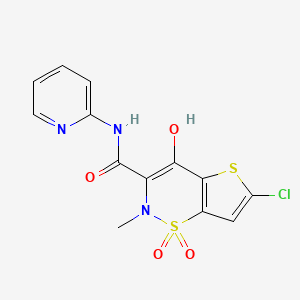



1. Chlortenoxicam
2. Xefocam
1. 70374-39-9
2. Chlortenoxicam
3. Xefocam
4. Xefo
5. Lorcam
6. Lornoxicamum
7. Ro 13-9297
8. Lornoxicamum [inn-latin]
9. Taigalor
10. Safem
11. Telos
12. Lorcam (tn)
13. Cltx
14. Lornoxicam (xefo)
15. Ccris 8589
16. Nsc-759620
17. Ro-13-9297
18. 6-chloro-4-hydroxy-2-methyl-1,1-dioxo-n-pyridin-2-ylthieno[2,3-e]thiazine-3-carboxamide
19. 6-chloro-4-hydroxy-2-methyl-n-(pyridin-2-yl)-2h-thieno[2,3-e][1,2]thiazine-3-carboxamide 1,1-dioxide
20. Chebi:31783
21. Er09126g7a
22. Chlortenoxicam;ro 13-9297;ts110
23. Ro-139297
24. 2h-thieno(2,3-e)-1,2-thiazine-3-carboxamide, 6-chloro-4-hydroxy-2-methyl-n-2-pyridinyl-, 1,1-dioxide
25. 6-chloro-4-hydroxy-2-methyl-n-pyridin-2-yl-2h-thieno[2,3-e][1,2]thiazine-3-carboxamide 1,1-dioxide
26. 70374-27-5
27. 6-chloro-4-hydroxy-2-methyl-1,1-dioxo-n-(pyridin-2-yl)-2h-1$l^{6},5,2-thieno[2,3-e][1$l^{6},2]thiazine-3-carboxamide
28. Smr000550483
29. Lornoxicam [usan:inn:ban]
30. Brn 1039965
31. Unii-er09126g7a
32. 2h-thieno[2,3-e]-1,2-thiazine-3-carboxamide, 6-chloro-4-hydroxy-2-methyl-n-2-pyridinyl-, 1,1-dioxide
33. Mfcd00866163
34. Lornoxicam [mi]
35. Lornoxicam [inn]
36. Lornoxicam [jan]
37. Lornoxicam [usan]
38. Lornoxicam [mart.]
39. Lornoxicam [who-dd]
40. Schembl35101
41. Schembl35102
42. 6-chloro-4-hydroxy-2-methyl-n-2-pyridinyl-2h-thieno[2,3-e]-1,2-thiazine-3-carboxamide 1,1-dioxide
43. 6-chloro-4-hydroxy-2-methyl-n-2-pyridyl-2h-thieno(2,3-e)-1,2-thiazine-3-carboxamide 1,1-dioxide
44. Mls001165721
45. Mls001304721
46. Mls006010084
47. Lornoxicam (jan/usan/inn)
48. Schembl1650239
49. Chembl1569487
50. Chembl3188235
51. Lornoxicam, >=98% (hplc)
52. Bdbm92331
53. Hms2231b07
54. Hms3264i20
55. Hms3655n13
56. Hms3887c17
57. Pharmakon1600-01502302
58. Ts110
59. Albb-014101
60. Bcp04666
61. Hy-b0367
62. Zinc5318420
63. Nsc759620
64. S2047
65. Stl504715
66. Ts-110
67. Zinc49089868
68. Akos000281810
69. Akos026750113
70. Zinc100015491
71. Ab07518
72. Ac-4675
73. Bcp9000860
74. Ccg-213023
75. Db06725
76. Ks-1080
77. Nsc 759620
78. Ncgc00246566-01
79. Ncgc00346667-01
80. Ncgc00346667-02
81. 6-chloro-4-hydroxy-2-methyl-3-(2-pyridylcarbamoyl)-2h-thieno[2,3-e]-1,2-thiazine-1,1-dioxide
82. Hn-10000
83. Bcp0726000036
84. Ft-0630797
85. Ft-0670854
86. L0239
87. Sw220125-1
88. C76243
89. D01866
90. Ab00876293_04
91. Ab00876293_06
92. 374l399
93. A836864
94. Sr-01000799148
95. Q-101309
96. Q2734874
97. Sr-01000799148-3
98. (3e)-6-chloro-3-[hydroxy(pyridin-2-ylamino)methylene]- 2-methyl-2,3-dihydro-4h-thieno[2,3-e][1,2] Thiazin- 4 - One 1,1-dioxide
99. (3e)-6-chloro-3-[hydroxyl(pyridin-2-ylamino)methylene]-2-methyl-2,3-dihydro-4h-thieno[2,3-e][1,2]thiazin-4-one 1,1-dioxide
100. (3z)-6-chloranyl-2-methyl-1,1-bis(oxidanylidene)-3-[oxidanyl-(pyridin-2-ylamino)methylidene]thieno[2,3-e][1,2]thiazin-4-one
101. (3z)-6-chloro-3-[hydroxy-(2-pyridinylamino)methylidene]-2-methyl-1,1-dioxo-4-thieno[2,3-e]thiazinone
102. 2h-thieno(3,2-e)-1,2-thiazine-3-carboxamide, 6-chloro-4-hydroxy-2-methyl-n-2-pyridinyl-, 1,1-dioxide
103. 6-chloro-4-hydroxy-2-methyl-1,1-dioxo-n-(pyridin-2-yl)-2h-1
104. E?-thieno[2,3-e][1,2]thiazine-3-carboxamide
105. 6-chloro-4-hydroxy-2-methyl-n-(2-pyridyl)-2h-thieno[2,3-e][1,2]thiazine-3-carboxamide 1,1-dioxide
106. 6-chloro-4-hydroxy-2-methyl-n-(pyridin-2-yl)-2h-thieno[2,3-e][1,2]thiazine-3-carboxamide1,1-dioxide
107. 6-chloro-4-hydroxy-2-methyl-n-pyridin-2-yl-2h-thieno[2,3-e][1,2]thiazine-3-carboxamide 1,1-dioxide (lornoxicam)
108. 6-chloro-4-hydroxy-2-methyl-n-pyridin-2-yl-2h-thieno[2,3-e][1,2]thiazine-3-carboxamide-1,1-dioxide
| Molecular Weight | 371.8 g/mol |
|---|---|
| Molecular Formula | C13H10ClN3O4S2 |
| XLogP3 | 2.1 |
| Hydrogen Bond Donor Count | 2 |
| Hydrogen Bond Acceptor Count | 7 |
| Rotatable Bond Count | 2 |
| Exact Mass | 370.9801258 g/mol |
| Monoisotopic Mass | 370.9801258 g/mol |
| Topological Polar Surface Area | 136 Ų |
| Heavy Atom Count | 23 |
| Formal Charge | 0 |
| Complexity | 634 |
| Isotope Atom Count | 0 |
| Defined Atom Stereocenter Count | 0 |
| Undefined Atom Stereocenter Count | 0 |
| Defined Bond Stereocenter Count | 0 |
| Undefined Bond Stereocenter Count | 0 |
| Covalently Bonded Unit Count | 1 |
For the treatment of acute mild to moderate pain, as well as pain and inflammation of the joints caused by certain types of rheumatic diseases.
Lornoxicam is a non-steroidal anti-inflammatory drug (NSAID) that belongs to the oxicam class. As with other NSAIDS, lornoxicam is a potent inhibitor of the cyclooxgenase enzymes, which are responsible for catalyzing the formation of prostaglandins (act as messenger molecules in the process of inflammation) and thromboxane from arachidonic acid. Unlike some NSAIDS, lornoxicam's inhibition of cyclooxygenase does not lead to an increase in leukotriene formation, meaning that arachidonic acid is not moved to the 5-lipoxygenase cascade, resulting in the minimization of the risk of adverse events.
Anti-Inflammatory Agents, Non-Steroidal
Anti-inflammatory agents that are non-steroidal in nature. In addition to anti-inflammatory actions, they have analgesic, antipyretic, and platelet-inhibitory actions. They act by blocking the synthesis of prostaglandins by inhibiting cyclooxygenase, which converts arachidonic acid to cyclic endoperoxides, precursors of prostaglandins. Inhibition of prostaglandin synthesis accounts for their analgesic, antipyretic, and platelet-inhibitory actions; other mechanisms may contribute to their anti-inflammatory effects. (See all compounds classified as Anti-Inflammatory Agents, Non-Steroidal.)
M - Musculo-skeletal system
M01 - Antiinflammatory and antirheumatic products
M01A - Antiinflammatory and antirheumatic products, non-steroids
M01AC - Oxicams
M01AC05 - Lornoxicam
Absorption
Lornoxicam is absorbed rapidly and almost completely from the GI tract (90-100%).
Lornoxicam is metabolized completely by cyp 2C9 with the principal metabolite being 5'-hydroxy-lornoxicam and only negligible amounts of intact lornoxicam are excreted unchanged in the urine. Approximately 2/3 of the drug is eliminated via the liver and 1/3 via the kidneys in the active form.
Lornoxicam has known human metabolites that include 5'-Hydroxylornoxicam.
S73 | METXBIODB | Metabolite Reaction Database from BioTransformer | DOI:10.5281/zenodo.4056560
3-5 hours
Like other NSAIDS, lornoxicam's anti-inflammatory and analgesic activity is related to its inhibitory action on prostaglandin and thromboxane synthesis through the inhibition of both COX-1 and COX-2. This leads to the reduction of inflammation, pain, fever, and swelling, which are mediated by prostaglandins. However, the exact mechanism of lornoxicam, like that of the other NSAIDs, has not been fully determined.
